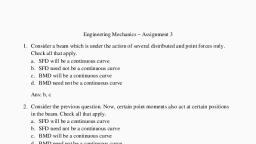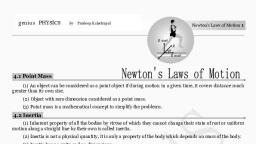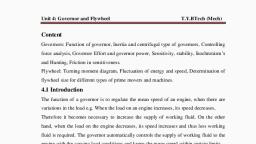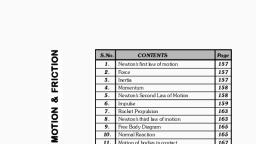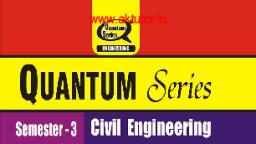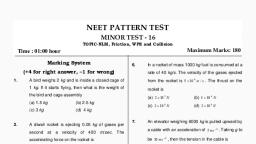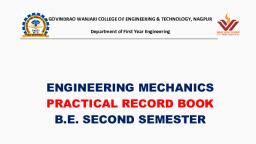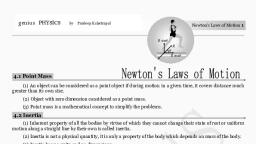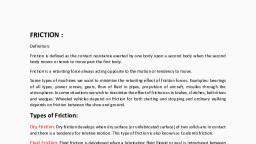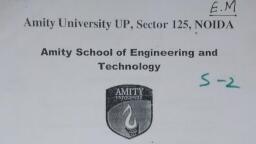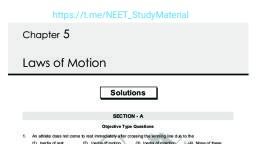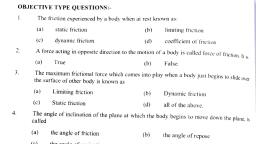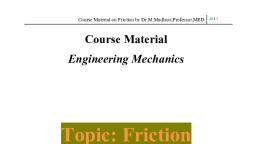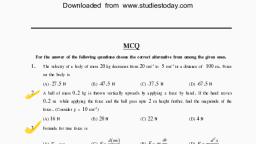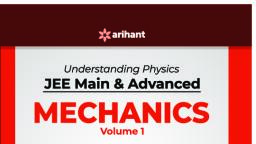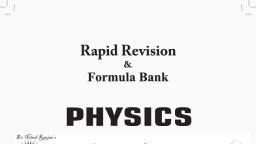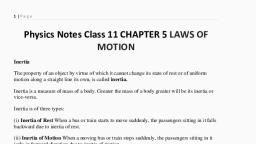Page 1 :
Engineering Mechanics, , Friction in Action
Page 2 :
What is friction?, ■, , ■, , Friction is a retarding force that opposes, motion., Friction types:, ❑, ❑, ❑, , ■, , Dry or, Coulombic, friction, , Sources of dry friction, ❑, ❑, , ■, , Static friction, Kinetic friction, Fluid friction, , Asperities between contacting surfaces, Interactions at the atomic level, , Tribology studies sources of friction,, lubrication, wear and tear etc.
Page 4 :
The Laws of Dry Friction. Coefficients of, Friction, • Maximum static-friction force:, , • Kinetic-friction force:, , • Maximum static-friction force and kineticfriction force are:, - proportional to normal force, - dependent on type and condition of, contact surfaces, - independent of contact area
Page 5 :
Vector Mechanics for Engineers: Statics, , Tenth Edition, n SI Units, , The Laws of Dry Friction. Coefficients of Friction, • Four situations can occur when a rigid body is in contact with a, horizontal surface:, , • No friction,, (Px = 0), , • No motion,, (Px < F), , • Motion impending,, (Px = Fm), , © 2013 The McGraw-Hill Companies, Inc. All rights reserved., , • Motion,, (Px > Fm), , 5
Page 6 :
Vector Mechanics for Engineers: Statics, , Tenth Edition, n SI Units, , Angles of Friction, • It is sometimes convenient to replace normal force N and friction, force F by their resultant R:, , • No friction, , • No motion, , • Motion impending, , © 2013 The McGraw-Hill Companies, Inc. All rights reserved., , • Motion, , 6
Page 7 :
Vector Mechanics for Engineers: Statics, , Tenth Edition, n SI Units, , Angles of Friction, • Consider block of weight W resting on board with variable inclination, angle θ., , • No friction, , • No motion, , • Motion impending, , © 2013 The McGraw-Hill Companies, Inc. All rights reserved., , • Motion, , 7
Page 8 :
Vector Mechanics for Engineers: Statics, , Tenth Edition, n SI Units, , Problems involving Dry Friction, , • All applied forces known, , • All applied forces known, , • Coefficient of static, friction is known, , • Coefficient of static friction • Motion is impending, • Motion is impending, is known, • Determine value of coefficient, • Determine magnitude or, • Determine whether body will of static friction., direction of one of the, remain at rest or slide, applied forces, , © 2013 The McGraw-Hill Companies, Inc. All rights reserved., , 8
Page 9 :
Vector Mechanics for Engineers: Statics, , Tenth Edition, n SI Units, , Sample Problem 8.1, SOLUTION:, • Draw the free body diagram for the, block. Remember that the friction, force is opposite the direction of, impending motion., • Determine values of friction force and, normal reaction force from plane, required to maintain equilibrium., A 100-N force acts as shown on a 300-N, block placed on an inclined plane. The, coefficients of friction between the block, and plane are µs = 0.25 and µk = 0.20., Determine whether the block is in, equilibrium and find the value of the, friction force., © 2013 The McGraw-Hill Companies, Inc. All rights reserved., , • Calculate maximum friction force and, compare with friction force required, for equilibrium. If it is greater, block, will not slide., • If maximum friction force is less than, friction force required for, equilibrium, block will slide., Calculate kinetic-friction force., 9
Page 10 :
Vector Mechanics for Engineers: Statics, , Tenth Edition, n SI Units, , Sample Problem 8.1, SOLUTION:, • Determine values of friction force and normal, reaction force from plane required to maintain, equilibrium., , What does the sign, tell you about the, assumed direction of, impending motion?, , • Calculate maximum friction force and compare, with friction force required for equilibrium., What does this solution imply about the block?, The block will slide down the plane., , © 2013 The McGraw-Hill Companies, Inc. All rights reserved., , 10
Page 11 :
Vector Mechanics for Engineers: Statics, , Tenth Edition, n SI Units, , Sample Problem 8.1, • If maximum friction force is less than friction force, required for equilibrium, block will slide., Calculate kinetic-friction force., , © 2013 The McGraw-Hill Companies, Inc. All rights reserved., , 11
Page 12 :
How to invoke laws of friction?, Key: Always keep track of the number of, unknowns and the number of equilibrium, equation., Read : Beer and Johnston 8th Ed. pgs 441-442, ■, , Problem type 1:, ❑, ❑, ❑, , Like a usual equilibrium problem, Solve using what we learnt earlier, Only a couple of changes:, ■, , ■, , ■, , ■, , Verify if the surface is capable of handling the load, OR, Find the minimum friction coefficient required., OR, Given slipping occurs find the friction coefficient., , Friction law need to be used at the very end.
Page 13 :
Problem 1, ■, , The friction tongs shown are, used to lift a 750-lb casting., Knowing that h = 35in., determine the smallest, allowable value of the coefficient, of static friction between the, casting and blocks D and D’.
Page 14 :
SI Version, ■, , The friction tongs shown are used to lift a 350 kg casting., Knowing that h = 864 mm, determine the smallest, allowable value of the coefficient of static friction between, the casting and blocks D and D’., 216 mm, , 162 mm, , 288 mm, , 350 kg, 144 mm, , 14
Page 16 :
Problem 2, A woman pedals her bicycle up a 5-percent grade and a slippery road, at a steady speed. The woman and bicycle have a combined mass of 82, kg. with mass center at G. If the rear wheel is on the verge of slipping,, determine the coefficient of friction µs between the rear tire and the road., If the coefficient of friction is doubled, what would be the friction force, acting on the rear wheel? (why may we neglect friction under the front, wheel)
Page 18 :
Problem 3, ■, , The light bar is used to support the 50-kg block in its vertical, guides. If the coefficient of static friction is 0.3 at the upper, end of the bar and 0.4 at the lower end of the bar, find the, friction force acting on each end for x = 75mm. Also find the, maximum value of x for which the bar will not slip.
Page 20 :
Stone Crusher Problem, Two large cylinders, each of radius r = 500 mm rotate in opposite, directions and form the main elements of a crusher for stone aggregates., The distance d is set equal to the maximum desired size of the crushed, aggregate. If d = 20 mm, µs = 0.3, determine the size of the largest stones, which will be pulled through the crusher by friction alone. Assume the, stone to be symmetrically placed on both wheels, and that the weight of, the stone is negligible compared to the contact forces., r, , r, , s, , 20
Page 21 :
Stone Crusher Problem - Solution, N, , F, W, , F, , N, , F, , N, FBD of Aggregate, , FBD of Crusher Cylinder, , From FBD of aggregate it can be seen that the aggregate will pass, through the crusher cylinders due to its self weight and the friction forces, from the two cylinders., Since the aggregate passes through the crusher due to friction alone, it, implies that the self weight of the aggregate is neglected in this case., Thus the aggregate reduces to a two-force body subjected to reaction, forces from the cylinders at two points only and along the same line., 21
Page 22 :
Stone Crusher Problem - Solution, θ N, R, , R, , R, , F, FBD of Aggregate, FBD of Crusher Cylinder, , r = 500 mm, d = 20 mm, µs = 0.3, , The aggregate and cylinder will be at the point of slipping when the, maximum size aggregate passes., , 22
Page 23 :
Stone Crusher Problem - Solution, S/2, θ, r
+
d/2, Centerline
of
Crusher
, Cylinders, , r = 500 mm, d = 20 mm, µs = 0.3, , From
the
arrangement
of
the
crusher
and
the
maximum
aggregate, , 23
Page 24 :
Problem Type 2, ■, , ■, ■, , Number of equations is less than number of, unknowns., Motion of the body is impending., You are asked to obtain:, ❑, , ❑, , ■, , ■, , Force/Torque required to start the impending, motion., Some distance, angle etc. for the impending, motion., , Need to use the law of friction at impending, surface., Careful about the sign of forces.
Page 25 :
Problem 4, ■, , The coefficients of friction are µs = 0.4 and µk = 0.3 between all, surfaces of contact. Determine the force P for which motion of the, 30-kg block is impending if cable AB (a) is attached as shown, (b), is removed. Assume that the cord is inextensible and the pulleys, are well oiled.
Page 27 :
Problem 40, The moveable bracket shown may be placed at any height on the 30, mm diameter pipe. If the coefficient of friction between the pipe and, bracket is 0.25, determine the minimum distance x at which the load, can be supported. Neglect the weight of the bracket., , 27
Page 28 :
Problem 40 - Solution, , Given- Diameter of the pipe=30mm;, y, , Height of the bracket=60mm., x, , µ =0.25, FBD of Bracket, , As the bracket is loaded as shown, the reaction forces on the bracket by, the pipe is at only 2 points as shown., , 28
Page 29 :
Problem 40 - Solution, , Given- Diameter of the pipe=30mm;, Height of the bracket=60mm., FBD of Bracket, , µ =0.25, , 29
Page 30 :
Problem Type 3, ■, ■, ■, , ■, , ■, , Similar to Problem Type 2, but with one significant difference, There can be multiple modes of slipping., Which particular contact at which the impending slippage, occurs have to be decided by, ❑ Trial and error, ❑ Inspection, ❑ Physical intuition., Ultimately it must be checked that everything is consistent,, i.e., the force on surfaces other than slipping surfaces should, be less than µN., Caution: Be careful about the direction of forces
Page 31 :
Problem 4a, ■, , A light metal panel is welded to two short sleeves of 0.025 m inside, diameter that can slide on a fixed horizontal rod. The coefficient of friction, between the sleeves and the rod are μs = 0.4 and μk = 0.3. A cord attached to, corner C is used to move the panel along the rod. Knowing that the cord lies, in the same vertical plane as the panel, determine the range of values of θ for, which the panel will be in impending motion to the right. Assume that, sleeves make contact with the rod at the exterior points A and B., , A, B, , C
Page 32 :
Metal Panel Problem – Two cases, NA, , FA, , NB, , NA, , FB, , FA, , θ, FBD – Case (i), Small angle, , NB, FB, , P, , θ, , P, , FBD – Case (ii), Large angle, , There will two possible situations of loads acting on the panel as shown, in the FBDs above:, 32
Page 33 :
Metal Panel Problem - Solution, Case (i), , From equilibrium conditions of the panel we get, d, y, , h, x, b, b = 400 mm, h = 612.5 mm, d = 25 mm, , If θ > 21.80 the panel will move to the right under a net force of, Therefore for case (i) the panel will move to the right if, 33
Page 34 :
Metal Panel Problem - Solution, Case (ii), , From equilibrium conditions of the panel we get, d, h, Can also take, Moment w.r.t B, b, b = 400 mm, h = 625 mm, d = 25 mm, , 34
Page 35 :
Problem 4b, ■, , For the previous problem 4a, assuming that the cord is attached at point E at, a distance x = 0.1 m from the corner C. (b) Determine the largest value of x for, which the panel can be moved to the right., , E, x
Page 36 :
Problem 5, ■, , A block of mass mo is placed between, the vertical wall and the small ideal, roller at the upper end A of the, uniform slender bar of mass m. The, lower end B of the bar rests on the, horizontal surface. If the coefficient, of static friction is μs at B and also, between the block and the wall,, determine a general expression for, the minimum value θmin of θ for, which the block will remain in, equilibrium. Evaluate the expression, for μs = 0.5 and m/mo = 10. For, these conditions, check for possible, slipping at B.
Page 38 :
Problem 6, ■, , The 12-lb slender rod AB is pinned at A and rests on the 36-lb, cylinder C. Knowing that the diameter of the cylinder is 12.5 in. and, that the coefficient of static friction is 0.35 between all surfaces of, contact, determine the largest magnitude of the force P for which, equilibrium is maintained
Page 40 :
Problem 9, , • Determine the force P required to move the two, identical rollers up the incline. Each role weighs, 30lb, and the coefficient of friction at all, contacting surfaces is 0.2.
Page 42 :
Problem 5, ■, , Two slender rods of negligible weight are pinconnected at A and attached to the 18-lb block B, and the 80-lb block C as shown. The coefficient of, static friction is 0.55 between all surfaces of, contact. Determine the range of values of P for, which equilibrium is maintained
Page 43 :
Problem 3, ■, , What is the force F to hold two cylinders, each, having a mass of 50 kg? Take the coefficient of, friction equal to 0.2 for all surfaces of contact.
Page 44 :
Problem Type 4, ■, ■, , ■, , ■, , Whether there is an impending slipping or tipping., If slipping occurs:, ❑ F = µN, at the point of slipping, If tipping occurs, ❑ Reactions at all points other than the point of tipping is equal, to zero., Note that this case is just a special case of what we have seen, earlier.
Page 45 :
Problem 7, , • A homogenous block of weight W rests on a, horizontal plane and is subjected to the, horizontal force P as shown. If the coefficient of, friction is μ, determine the greatest value, which h may have so that the block will slide, without tipping.
Page 48 :
Problem 8, , • The device shown prevents clockwise rotation, in the horizontal plane of the central wheel by, means of frictional locking of the two small, rollers. For given values of R and r and for a, common coefficient of friction μ
at all contact, surfaces, determine the range of values of d for, which the device will operate as described., Neglect weight of the two rollers.
Page 50 :
QUESTION?, SUGGESTIONS?
Page 51 :
Problem 1, , • What is the height h of the step so that the, force P will role the cylinder of weight 25kg, over the step without impending slippage at, the point of contact A. Take the coefficient, of friction to be equal to 0.3.
Page 53 :
Problem 1b, , • A car is stopped with its front wheels resting against a, curb when its driver starts the engine and tries to drive, over the curb. Knowing that the radius of the wheels is, 280 mm, that the coefficient of static friction between, the tires and the pavement is 0.85, and that the weight of, the car is equally distributed over its front and rear, wheels, determine the largest curb height h that the car, can negotiate, assuming (a) front wheel drive, and (b), rear wheel drive.
Page 54 :
Problem 2, , • A 5 deg wedge is used to lift the 1000-lb, cylinder as shown. If the coefficient of, friction is ¼ for all surfaces, determine the, force P required to move the wedge.
Page 56 :
Problem 3, θ = 35 deg, ■, , A slender rod of length L, is lodged between peg C, and the vertical wall and, supports a load P at end, A. Knowing that, and, that the coefficient of, static friction is 0.20 at, both B and C, determine, the range of values of the, ratio L/a for which, equilibrium, is, maintained., , 3.46 < L/a < 13.63
Page 57 :
Problem 4, The moveable bracket shown may be placed at any height on the 3-cm, diameter pipe. If the coefficient of friction between the pipe and bracket is, 0.25, determine the minimum distance x at which the load can be supported., Neglect the weight of the bracket.
Page 58 :
Problem 5, ■, , Two slender rods of negligible weight are pinconnected at A and attached to the 18-lb block B, and the 80-lb block C as shown. The coefficient of, static friction is 0.55 between all surfaces of, contact. Determine the range of values of P for, which equilibrium is maintained
Page 59 :
Problem 2, ■, , What is the minimum coefficient of friction, required just to maintain the bracket and its 250, kg load? The center of gravity is 1.8m from the, centerline.
Page 60 :
Problem 3, ■, , What is the force F to hold two cylinders, each, having a mass of 50 kg? Take the coefficient of, friction equal to 0.2 for all surfaces of contact.
Page 61 :
COMPLEX FRICTION
Page 62 :
Square-Threaded Screws, • Square-threaded screws are frequently used in jacks, presses,, etc. Analysis is similar to block on inclined plane. Recall that, friction force does not depend on area of contact., • Thread of base has been “unwrapped” and shown as straight, line. Slope is 2πr horizontally by L vertically., • Moment of force Q is equal to moment of force P., , • Impending motion, upwards. Solve for Q., , •, , Self-locking, solve, for Q to lower load., , •, , Non-locking, solve, for Q to hold load., 62
Page 63 :
Vector Mechanics for Engineers: Statics, , Tenth Edition, n SI Units, , Journal Bearings. Axle Friction, • Journal bearings provide lateral support to rotating, shafts. Thrust bearings provide axial support, • Frictional resistance of fully lubricated bearings, depends on clearances, speed and lubricant viscosity., Partially lubricated axles and bearings can be, assumed to be in direct contact along a straight line., • Forces acting on bearing are weight W of wheels and, shaft, couple M to maintain motion, and reaction R, of the bearing., • Reaction is vertical and equal in magnitude to W., • Reaction line of action does not pass through shaft, center O; R is located to the right of O, resulting in a, moment that is balanced by M., • Physically, contact point is displaced as axle, “climbs” in bearing., © 2013 The McGraw-Hill Companies, Inc. All rights reserved., , 63
Page 64 :
Vector Mechanics for Engineers: Statics, , Tenth Edition, n SI Units, , Thrust Bearings. Disk Friction, Consider rotating hollow shaft:, , For full circle of radius R,, , © 2013 The McGraw-Hill Companies, Inc. All rights reserved., , 64
Page 65 :
Belt Friction
Page 66 :
Vector Mechanics for Engineers: Statics, , Tenth Edition, n SI Units, , Belt Friction, • Relate T1 and T2 when belt is about to slide to right., • Draw free-body diagram for element of belt, , • Combine to eliminate ΔN, divide through by Δθ,, , • In the limit as Δθ goes to zero,, , • Separate variables and integrate from, , © 2013 The McGraw-Hill Companies, Inc. All rights reserved., , 66
Page 67 :
Belt
Friction
, Application, capstan, , Diesel
engine, , motor
belt, , Band
Brake, , 67
Page 68 :
Problem 46, ■, , A pulley requires 200 Nm torque to get it rotating in the direction as, shown. The angle of wrap is π radians, and µs = 0.25. What is the, minimum horizontal force F required to create enough tension in the, belt so that it can rotate the pulley?, T2, 250 mm, , T1, 68
Page 71 :
Problem 47, A flat belt connects pulley A to pulley B. The coefficients of friction are, µs = 0.25 and µk = 0.20 between both pulleys and the belt. Knowing that, the maximum allowable tension in the belt is 600 N, determine the, largest torque which can be exerted by the belt on pulley A., , 71
Page 72 :
Problem 47 - Solution, T1, , T2 = 600 N, , T1 = 355.4 N, T2 = 600 N, , • Since angle of contact is smaller, slippage will occur on pulley B first., Determine belt tensions based on pulley B., , • Equating moments acting on pulley A we get, 72
Page 73 :
Problem 48, Knowing that the coefficient of static friction is 0.25 between the rope, and the horizontal pipe and 0.20 between the rope and the vertical, pipe, determine the range of values of P for which equilibrium is, maintained., , N, 73
Page 74 :
Problem 48 - Solution, , T=100N, µ1=0.25 (between rope & horizontal pipe), µ2=0.20 (between rope &vertical pipe), , N, , Consider the sections of the rope as shown. Due to the friction, the tension in each, part is different., P will be max if there is impending slip in the direction of P (i.e. P>T2>T1>T)., P will be min if there is impending slip in the direction of T (i.e. P<T2<T1<T).
Page 77 :
Problem 49, ■, , A cord is wiped twice around a pole A and three times around, second pole B. Finally cord goes over a half barrel section and, supports a mass M of 500 kg. What is tension T required to, maintain this load? Take coefficient of friction 0.1 for all, surfaces of contact., , 77
Page 78 :
Problem 49 - Solution, , m=500kg,, µ=0.1. So,, T1=Mg=500*9.81=4905N, , Consider the sections of the rope as shown. Due to the friction, the tension in each part is, different., T will be max if there is impending slip in the direction of T (i.e. T>T3>T2>T1)., T will be min if there is impending slip in the direction opposite to T (i.e. T<T3<T2<T1)., For the values of T greater than min and lesser than max, it can maintain the load.
Page 81 :
Extra Problem, The seaman pulls with 100 N force and wants to stop the motor boat from, moving away from the dock. How many wraps he must make around the, post if the motor boat develops a thrust of 3500 N. (µs= 0.2 between rope, and the post), , 81
Page 82 :
Extra Problem - Solution, T1
=
100
N, T2
=
3500
N, , Considering friction in the pulley the forces T1 and T2 can be correlated as:, , where n = number of wraps of the rope around the post, From above n = 2.8, Therefore 3 wraps of the rope is necessary to restrain the motor boat, , 82

